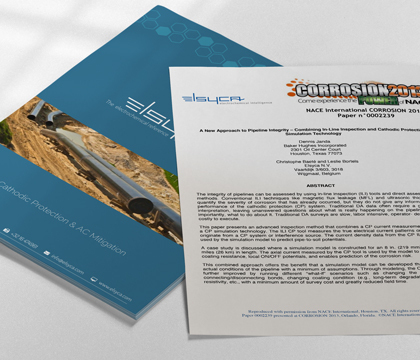
Combining In-Line Inspection and Cathodic Protection Simulation (NACE 2013)
Combining In-Line Inspection and Cathodic Protection Simulation Technology

Combining In-Line Inspection and Cathodic Protection Simulation (NACE 2013)
Christophe Baeté, Leslie Bortels, Elsyca n.v.; Dennis Janda, Baker Hughes Incorporated.
Abstract
The integrity of pipelines can be assessed by using in-line inspection (ILI) tools and direct assessment (DA) methods. Conventional ILI techniques like magnetic flux leakage (MFL) and ultrasonic thickness (UT) quantify the severity of corrosion that has already occurred, but they do not give any information on the performance of the cathodic protection (CP) system. Traditional DA data often require a great deal of interpretation, leaving unanswered questions about what is really happening on the pipeline and more importantly, what to do about it. Traditional DA surveys are slow, labor intensive, operator- dependent, and costly to execute.
This paper presents an advanced inspection method that combines a CP current measurement ILI tool with a CP simulation technology. The ILI CP tool measures the true electrical current patterns on the pipe that originate from a CP system or interference source. The current density data from the CP ILI tool are then used by the simulation model to predict pipe-to-soil potentials.
A case study is discussed where a simulation model is constructed for an 8 in. (219 mm) pipeline 16.15 miles (26 km) in length. The axial current measured by the CP tool is used by the model to predict the local coating resistance, local ON/OFF potentials, and enables prediction of the corrosion risk.
This combined approach offers the benefit that a simulation model can be developed that fits well to the actual conditions of the pipeline with a minimum of assumptions. Through modeling, the CP system can be further improved by running different “what-if” scenarios such as changing the rectifier outputs, connecting/disconnecting bonds, changing coating condition (e.g., long-term degradation), varying soil resistivity, etc., with a minimum amount of survey cost and greatly reduced field time.
Download pdf